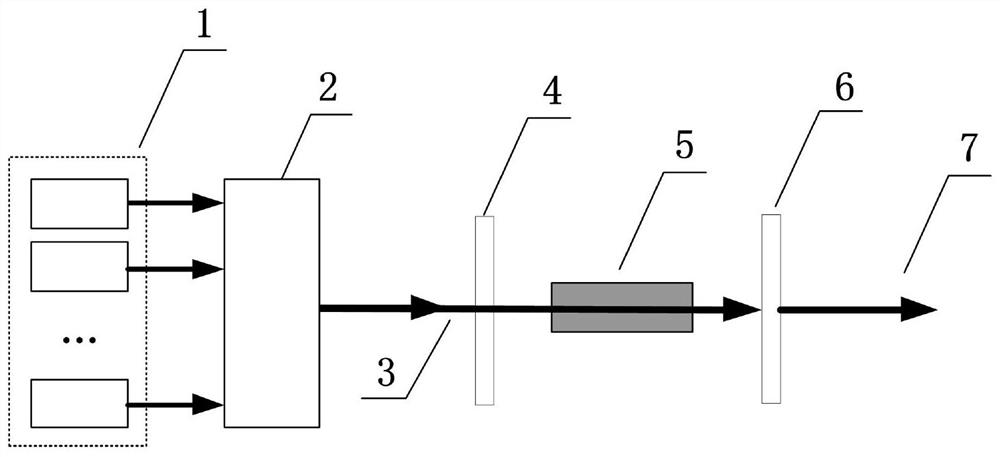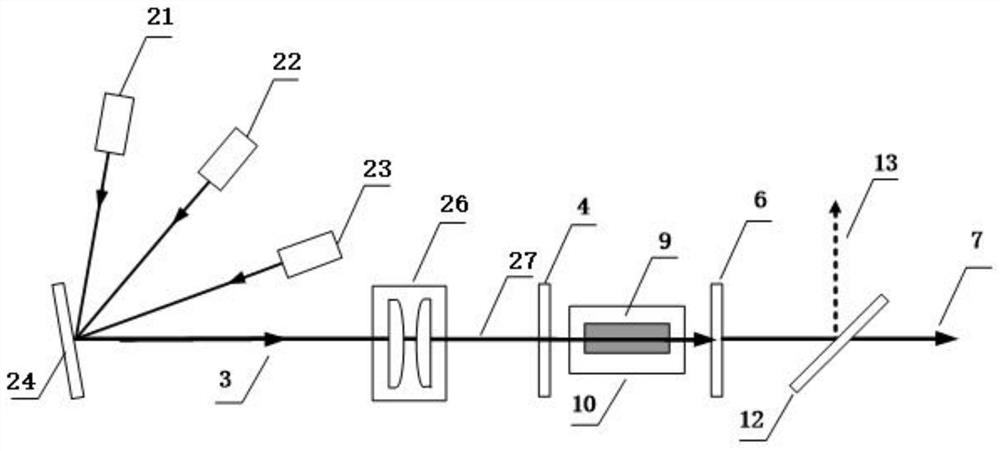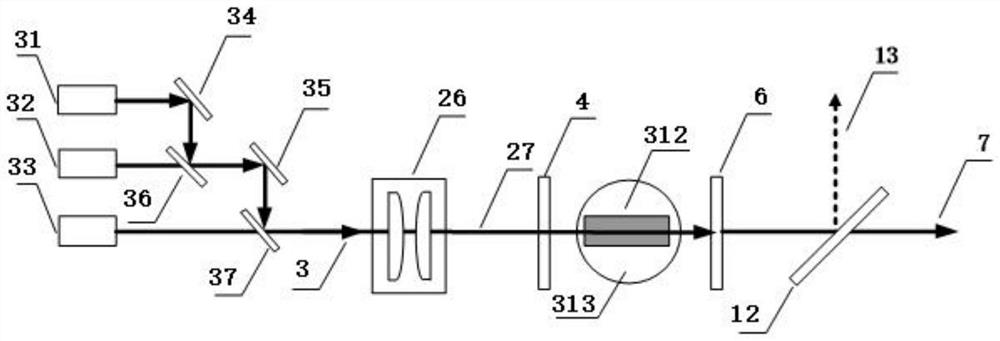Optical parameter conversion device for realizing ultra-wide spectrum laser output
An optical parameter, conversion device technology, applied in lasers, laser parts, phonon exciters, etc., can solve the problems of narrow output spectral range, high use cost, inability to meet, etc., to improve system integration and reduce system complexity degree and cost, the effect of reducing the number of optical components
- Summary
- Abstract
- Description
- Claims
- Application Information
AI Technical Summary
Problems solved by technology
Method used
Image
Examples
Embodiment 1
[0029] see figure 1 , an optical parameter conversion device for realizing ultra-wideband laser output according to the present invention, comprising n lasers with different wavelengths, a spectrum synthesis element, and an optical parameter converter;
[0030] The n different wavelength lasers are arranged in the order of wavelength, and the emitted laser light is incident on the spectrum synthesis element at the same time to form a wide spectral range spectrum synthesis laser output; the output lasers of the n different wavelength lasers are all linearly polarized lasers, n≥2, the output mode is continuous laser.
[0031] After the spectrally synthesized laser is output, it enters the optical parameter converter, and through the nonlinear optical action of the optical parameter converter, an optical parameter laser output with a wide spectral range is formed;
[0032] The optical parameter converter sequentially includes a laser input mirror, a nonlinear crystal and a laser...
Embodiment 2
[0034] see figure 2 , the first pulsed fiber laser, the second pulsed fiber laser, and the third pulsed fiber laser output laser center wavelengths are 1060nm, 1080nm, 1100nm respectively, the 3dB line width is 0.3nm, the average output power of each laser is 10W, and the pulse repetition frequency is 10kHz , the pulse width is 100ns, the beam quality is close to the diffraction limit, the output beam is parallel collimated output, and the spot radius is 2mm. The size of the diffraction grating is 10mm×10mm, and the groove density is 1200 grooves per millimeter. Each laser beam is calculated according to the grating diffraction formula, and is incident on the diffraction grating at angles of 45.46°, 47.46°, and 49.54° to the normal line of the grating, and is reflected by the diffraction grating to form a spectrally synthesized laser output. The spectrally synthesized laser and the normal line of the diffraction grating The included angle is 34°.
[0035] After the spectral...
Embodiment 3
[0037] see image 3, the center wavelengths of the first sub-beam, the first sub-beam and the third pulse are 2110nm, 2090nm, 2070nm respectively, the 3dB line width is 2nm, the average output power of each laser is 10W, the pulse repetition frequency is 10kHz, and the pulse width is 100ns, the beam quality is close to the diffraction limit, the output beam is parallel collimated output, and the spot radius is 2mm. The first reflecting mirror and the second reflecting mirror are coated with a 2060nm-2120nm high-reflection film, and the reflectivity of the 2060nm-2120nm is greater than 99%, and they are placed at an angle of 45° to the incident light beam. The first dichroic mirror is coated with 2108nm-2120nm high-reflection coating and 2080nm-2092nm anti-reflection coating. The reflectivity for 2108nm-2120nm is greater than 99%, and the transmittance for 2080nm-2092nm is greater than 97%. It is placed at an angle of 45° to the incident beam. The second dichroic mirror is coa...
PUM
 Login to View More
Login to View More Abstract
Description
Claims
Application Information
 Login to View More
Login to View More - R&D
- Intellectual Property
- Life Sciences
- Materials
- Tech Scout
- Unparalleled Data Quality
- Higher Quality Content
- 60% Fewer Hallucinations
Browse by: Latest US Patents, China's latest patents, Technical Efficacy Thesaurus, Application Domain, Technology Topic, Popular Technical Reports.
© 2025 PatSnap. All rights reserved.Legal|Privacy policy|Modern Slavery Act Transparency Statement|Sitemap|About US| Contact US: help@patsnap.com



